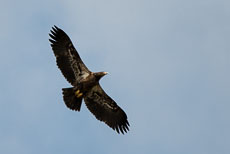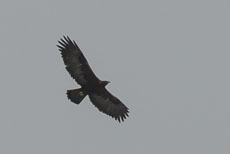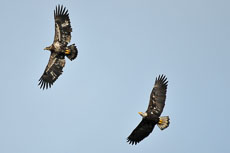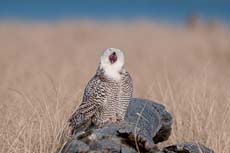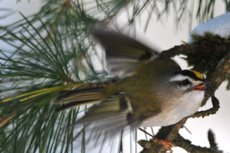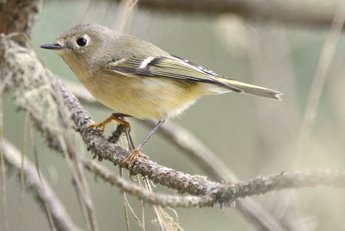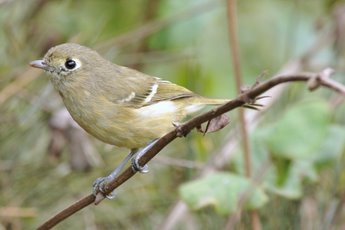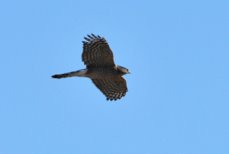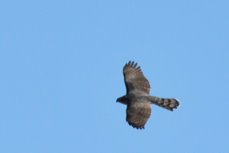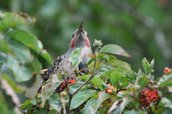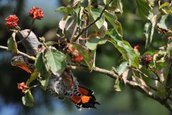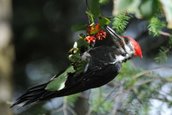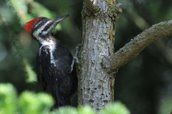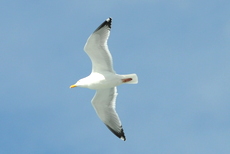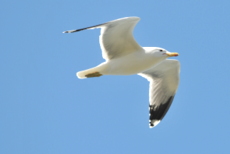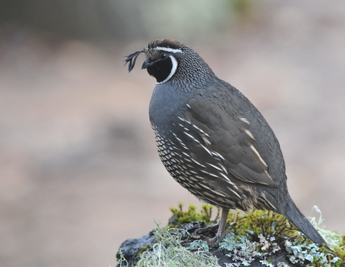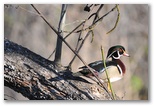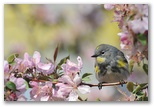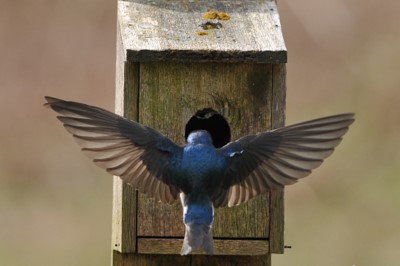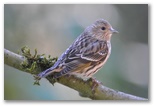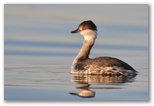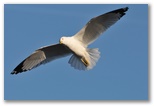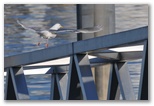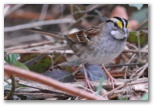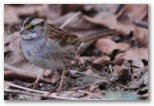
Brianpen Birds
2/7/2013 Bald vs Golden Eagle
The middle one is an adult Golden Eagle photographed in the Methow Valley in January. The other two images show juvenile Bald Eagles in various stages of development photographed in western Washington. Bald Eagles have longer heads and larger bills than Golden Eagles, and generally narrower wings as well. Juvenile Bald Eagles normally have white either in the underwing coverts or in the head or tail while juvenile Golden Eagles have white patches on the bases of the primaries, but subadult Goldens can have some pale feathers on the underwing coverts, possibly even resembling the Bald Eagle on the left. Distinguishing them gets easier with practice.2/27/2012 Snowy Owls
Snowy Owls have irrupted and are wintering across the country from Washington to Maine and in the midwest as far south as Oklahoma and Arkansas. We saw them in Ocean Shores, Washington today, where West Coast birders, amateur photographers and local merchants alike are all grateful for their presence though the local rodents and waterfowl, not so much. EBird has facilitated a flurry of interest in the birds but major newspapers have also reported on them and for at least one blogger they're an omen of the impending end of the world. For the Damon Point prey population, that might not be too far off the mark. About ten of the owls are spending the winter on Damon Point, resting quietly on driftwood logs scattered through the dune grass and peering for the most part without much interest at the crowds of photographers documenting them. They do make excellent photographic subjects, though some patience is required since they're not very active during the day. When they do wake up, their big yellow eyes are very expressive.11/23/2010 Golden-crowned Kinglets
What's it like to be a Golden-crowned Kinglet? Though among the smallest of our yard birds, I get the feeling that to each other, and perhaps to some of the other species around them, they're not so small. Sometimes I'm tempted to think that if all I have to show for a day is a few kinglet photos then my life must be pretty insignificant, but I doubt that Golden-crowned Kinglets even have a concept of insignificance. To judge by watching them face off over a promising needle cluster or scan a branch for their next meal, a kinglet's life is fraught with significance, an intensity of purpose that permits no distraction from the task at hand - the all-absorbing and minutely satisfying challenge of living a kinglet's life.10/21/2010 Kinglet or Vireo, Mendocino California
Birding and taking pictures in the pines and thickets on the headlands overlooking Mendocino Bay on the south side of town, I found lots of small birds - Chestnut-backed Chickadees, Pygmy Nuthatches, Bushtits, Yellow-rumped Warblers and both Ruby-crowned and Golden-crowned Kinglets. Not until I got back to the hotel and started reviewing my photos did I discover that not all of the Ruby-crowned Kinglets were kinglets. At least one of them was a Hutton's Vireo. They frequent the lowland hardwood forest in Washington too but I more often see them than hear them, but perhaps there too, I've been calling an occasional Hutton's Vireo a Ruby-crowned Kinglet instead. The kinglet has a black band below the wingbar while the vireo does not. The vireo has black feet, the kinglet yellow. The vireo bill is thicker and shorter and that might be the easiest mark to distinguish in the field, unless of course the bird is a male kinglet and he chooses to flash that vivid red gash in his scalp.09/30/2010 Accipiters, Indian Head Peak, North Cascades, WA
Hiking up Indian Head Peak from Meander Meadow along the Cascade Crest about 10 miles south of Glacier Peak, we spotted half a dozen Accipiters but I was only able to get photos of these two whose identities I've guessed at here. In the field I'd identified them a juvenile Cooper's and an adult Sharp-shinned (the two photos on the right) - based primarily on the speed of their wingbeats. After studying the photos, my guessis that all three are Sharp-shinneds. The juvenile has relatively coarse streaking, a squarish tail and forward-reaching wings, all of which would say Sharp-shinned. While the adult (both photos are the same individual) has a relatively long, rounded tail, a relatively large head and a straight leading wing edge, all characteristic (according to Sibley) of a Cooper's Hawk, the uniform gray shade of cap, back and sides of the neck says Sharp-shinned. An adult Coopers would have a dark cap contrasting with a paler nape and sides of the neck. If you have an opionion, feel free to use this form to share it with me.9/11/2010 Woodpeckers in the Dogwood
Every year in mid-September woodpeckers converge on the Dogwood tree in our back yard to feast on its red berries. Other birds, including Robins and Swainson's Thrushes, Cedar Waxwings and Starlings, enjoy the berries but the flickers and Pileated woodpeckers really seem to love them. Several of each spend a week or two in the Dogwood, starting high in the crown perhaps because they feel safer there (at least while I'm watching) and working their way down towards the ground as the berries higher in the tree are depleted. Every fall sometime while they're out there I climb up onto the roof with my tripod and camera and sit there for an hour or two trying for photos. Every year I also consider rigging up a blind thirty feet or so up in a nearby Doug Fir for closer shots but thinking about it is probably as far as I'll get on that project since the roof, though somewhat more distant, is a whole lot less trouble.04/29/2010 Three "seagulls", Mendocino California
Photographed three common western gull species at the Mendocino Headlands - Herring, California and Western - shown above side by side for comparison. The Herring has a small black wingtip sharply delineated from otherwise pale primaries and secondaries and has pink legs, a yellow iris and a red spot at the tip of the bill. In the California the black is more extensive but still sharply delineated from the pale underwing, the legs are yellowish, the iris dark and the spot at the tip of the bill is red and black. In the Western, the black wingtip grades into gray primaries and secondaries which are noticeably darker than on the other two gulls; the legs are pink, the bill spot is red and the iris varies from yellowish to dark-colored.04/27/2010 Two quail, Bottcher's Gap Campground, California
It's been more than 30 years since I've seen a Mountain Quail, and yesterday evening as we were driving up the winding road to Bottcher's Gap above the Big Sur coast of California, we came across a pair of them foraging along the side of the road less than 10 feet from the car. Pretty exciting, especially since I had no idea we'd see them there. We arrived fairly late at the campground and stayed up even later talking with the caretaker and a couple of other campers, one of whom came in after us and shared our site since both of the other sites by the parking area were occupied. In the morning I hiked up towards Devil's Peak until it began to rain, then returned to the car and packed up our soggy tent. In the car as we were continuing our conversation with the caretaker, a California Quail posed on a stump nearby. According to the caretaker a family of them generally frequents the campground. Here's my list of birds from the area.04/23/2010 Randolph E Collier rest area, northern California
On our way down to the Big Sur marathon we caught a wave of northbound warblers at the Randolph E Collier rest area along I-5 southbound where it crosses the Klamath River in northern California. Susan had been driving for a good part of the night when we pulled into the rest area around 7AM. I spotted some bird activity in some bushes along the river at the edge of the rest area grounds so I grabbed my tripod and 300mm lens and set off to look for birds while she took a nap in the car. I had a wonderful outing - not only did I get lots of warbler shots but I also found two of my favorite birds - Wood Ducks and Lewis's Woodpeckers. Here's my list along with some more photos.03/27/2010 Tree Swallow homecoming
They weren't here during my yardbird outing yesterday morning but this morning when David and I went out to photography the flowering Quince and the Rufous Hummingbird guarding it, we discovered that the Tree Swallows had returned and were already inspecting the nest box in the garden that they used last year. I parked out front with my 300 f4 on the tripod and got lucky with this shot of the male arriving at his summer home.03/15/2010 Utah Ferruginous Hawks
David and I drove to southern Utah for some canyon hiking and photography during his spring break, and on the way we came across both light and dark-phase Ferruginous Hawks near Milford in the high valleys of west-central Utah. The light-phase birds (there were two) were perched on an irrigation line along a snowy field dotted with ground-squirrel burrows just south of Milford. The dark-phase bird was about 50 miles farther north.02/28/2010 Western Meadowlarks
Although I only had 23 species during my yardbird outing this morning, one of them was a new all-time yard bird - a Western Meadowlark. I heard one singing in the distance, off to the east in the direction of a broad pasture owned by a dairy farmer who lives nearby. When I hear an unusual bird song in the neighborhood I'm always a little suspicious because too often I've investigated only to find a starling doing the singing. This one sounded authentic enough that after I finished the yardbird count I hiked over there to check it out. Sure enough, a big starling flock flew up from the pasture into some maple trees and amid the treetop cacaphony were fragments of meadowlark songs. But then I heard a real meadowlark song from out in the middle of the pasture. As I began to head over that way eight birds flew up from the wet grass, looking in the distance not unlike starlings but pale brown in color with white outer tail feathers. When they perched in a willow to face me I could pick out their yellow breasts with central black V's, as always too distant for photos. One in the willow and another in tall grass beyond it resumed singing and the sound of their clear warbling songs in the distance took me back to the grasslands of Saddle Mountain and beyond, dry air scented with sagebrush and sun starting to dispel the chill of the morning, the adventures of the day still ahead of me.02/27/2010 Ghost of Whidbey Marathon
Saw or heard 42 species during the Ghost of Whidbey Marathon today. The weather was decent for running, not so much for birding - mostly cloudy, high 40's with a brisk SE wind and intermittent light rain with a couple of brief sunbreaks. The wind kept the sparrows under cover - I only saw or heard one Song Sparrow - but didn't affect the gull and duck-viewing much. I carried binoculars which helped with the duck and gull id's. Altogether I counted 42 species in 5 hours between Coupeville and Bowman Beach, 8 more species and 75 minutes longer longer than the President's Day marathon two weeks ago.02/22/2010 Northern Saw-whet Owl
Heard a Northern Saw-whet Owl yesterday evening while I was taking out the trash, the first one we've had here since I began tracking yardbirds three years ago. It was calling at the edge of the woods near the end of our road, a series of single short hoots, about two per second, on a medium whistling pitch. In retrospect I should have gone looking for it but it was late and I was headed to bed - got to get up and go to work in the morning.02/21/2010 200-400mm f4 lens
I rented a 2004-400mm f4 lens from Glazers for the weekend. Saturday David and I drove down to Nisqually NWR but though the weather was beautiful, bird activity was minimal. The robin above was about my best shot. I did better with yardbirds in the morning before going out in the field. Sunday afternoon David and I went out again, this time launching the canoe from Thea's Park on the Tacoma waterfront and paddling up the mouth of the Puyallup river behind the big factory (paper mill?). We found a few gulls, mostly Glaucous-winged with a couple of Ring-billed and Mew Gulls. The Horned Grebe was along Ruston way the previous afternoon. The lens, by the way, is awesome, as sharp as I could desire and manageable without a tripod. Handling it well will take some practice, which I am looking forward to accumulating once I scrape together the cash to buy one of my own. They've been running about $5000 used on eBay, roughly seventy times the weekend rental charge.02/06/2010
Saw or heard 27 species during a yardbird outing this sunny mild morning. Highlights were two bald eagles flying by chirping at each other and a group of 6 Glaucous-winged gulls overhead. For the past month or so we've had a flock of 20 or so Pine Siskins in the neighborhood but only one at the feeder. Sometime this week the rest of the flock found the feeder, so today Pine Siskins were everywhere around the yard. Song Sparrows and Bewick's Wrens were singing and I heard a single Spotted Towhee song as well.01/31/2010
The 2010 yardbird list is up to 42 species as of yesterday, roughly half the species I'll see all year.01/22/2010 White-throated Sparrows
I finally succeeded in getting photos of both of the White-throated Sparrows today. Although I've seen one or the other from time to time, they're a little more secretive than the juncos and Golden-crowns so I haven't been able to get decent photos. I also haven't seen them together so haven't been sure that both were still around. With the help of photos it's not hard to tell them apart. The one on the left is the adult, with black crown stripes, bright white eyestripe and a fat yellow patch in front of and over the eye. Also the breast is clear gray and the belly nearly white. The first-winter bird on the right has brown mixed with black in the crown stripes, a dull white eyestripe with a narrow yellow wedge in front of the eye, a more mottled gray breast with an indistinct central spot and a mottled gray and white belly.01/17/2010
Saw or heard 25 species during a yardbird outing this morning, then spent the rest of the day creating the report page to display a trip list - something I've been meaning to do for a long time now. Next enhancement will be pages to enter bird sightings online, and after that, an interface to upload the sightings to eBird.01/02/2010
First yardbird outing of the year - 26 species. That's almost a third of all the species I'll see in/from the yard for the whole year.12/07/2009 White-throated Sparrows have returned
Last winter a single adult White-throated Sparrow showed up and spent the winter in the neighborhood. We put out seed in a feeder as well as scattered on the ground by the rose thickets along the driveway and though it didn't show up very often, I spotted it half a dozen times between December and April. About a week ago Susan filled the feeder for the first time this fall and two days ago an adult White-throated Sparrow showed up in the sparrow flock under the feeder. Yesterday I thought I saw a juvenile White-throated sparrow as well and today I saw both together, confirming my suspicion that there are two of them. I like to think that last year's adult returned with one of its offspring in tow but of course have no way of confirming my theory.In addition to the White-throated we have 8 or more Golden-crowned Sparrows including a couple of adults, up to 3 Fox Sparrows, 4 Spotted Towhees, several Song Sparrows, a flock of Dark-eyed Juncos in various configurations, a wary male House Sparrow, a pair of House Finches and a Varied Thrush all contending over the 10' square of leaf litter under the feeder. It's a busy scene.








